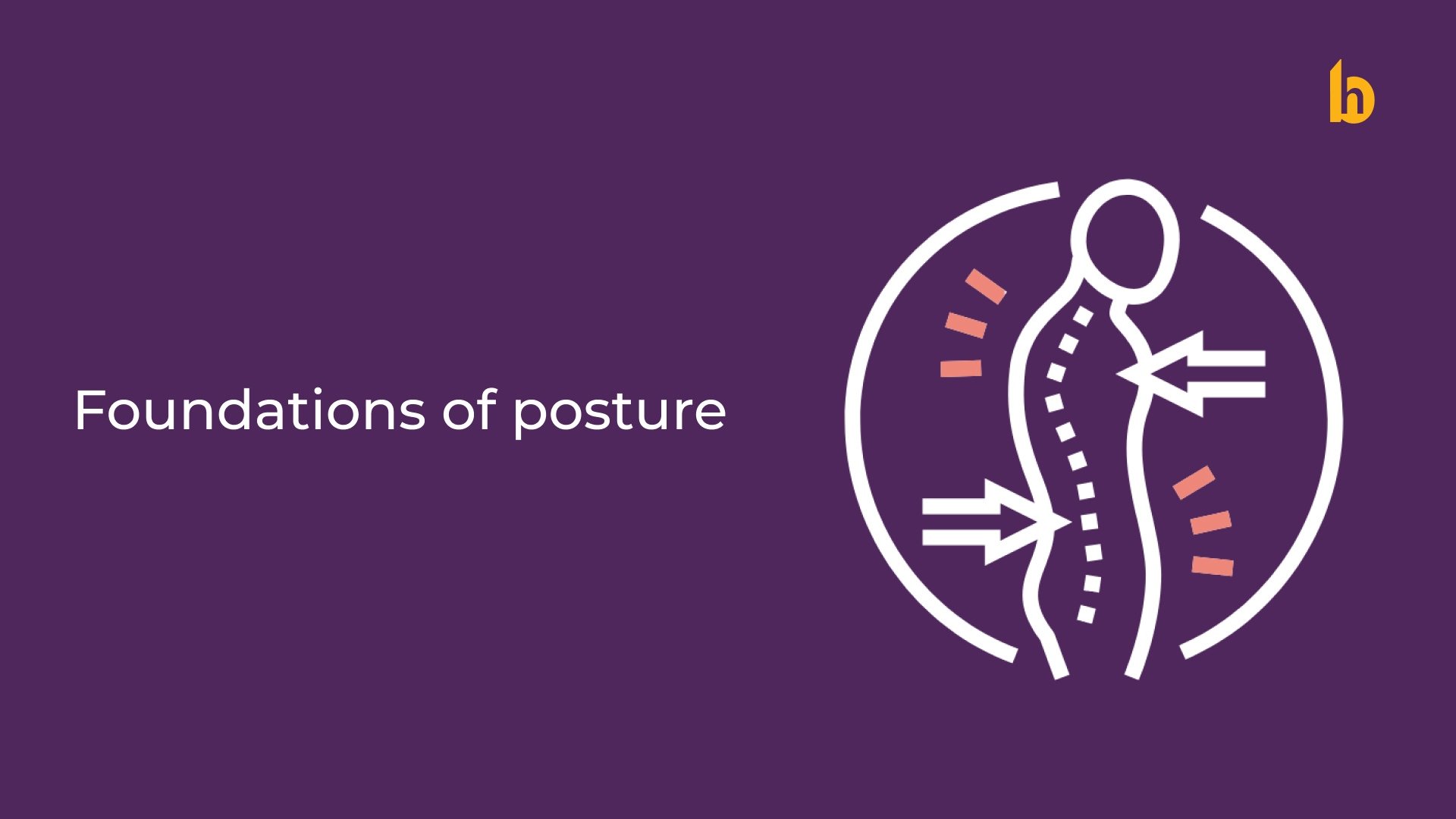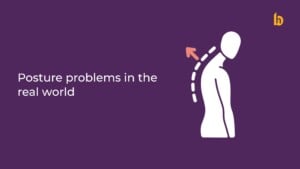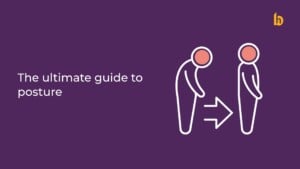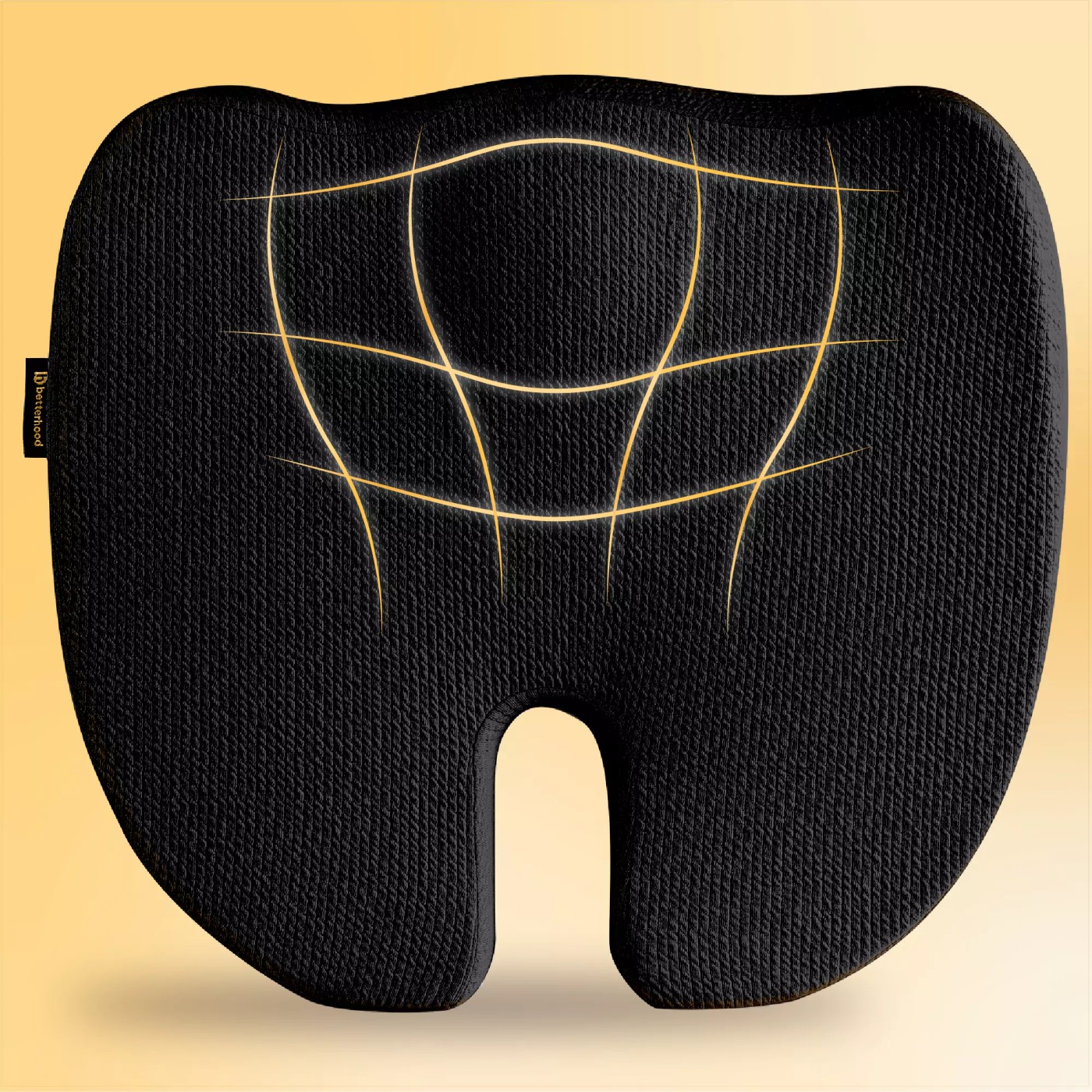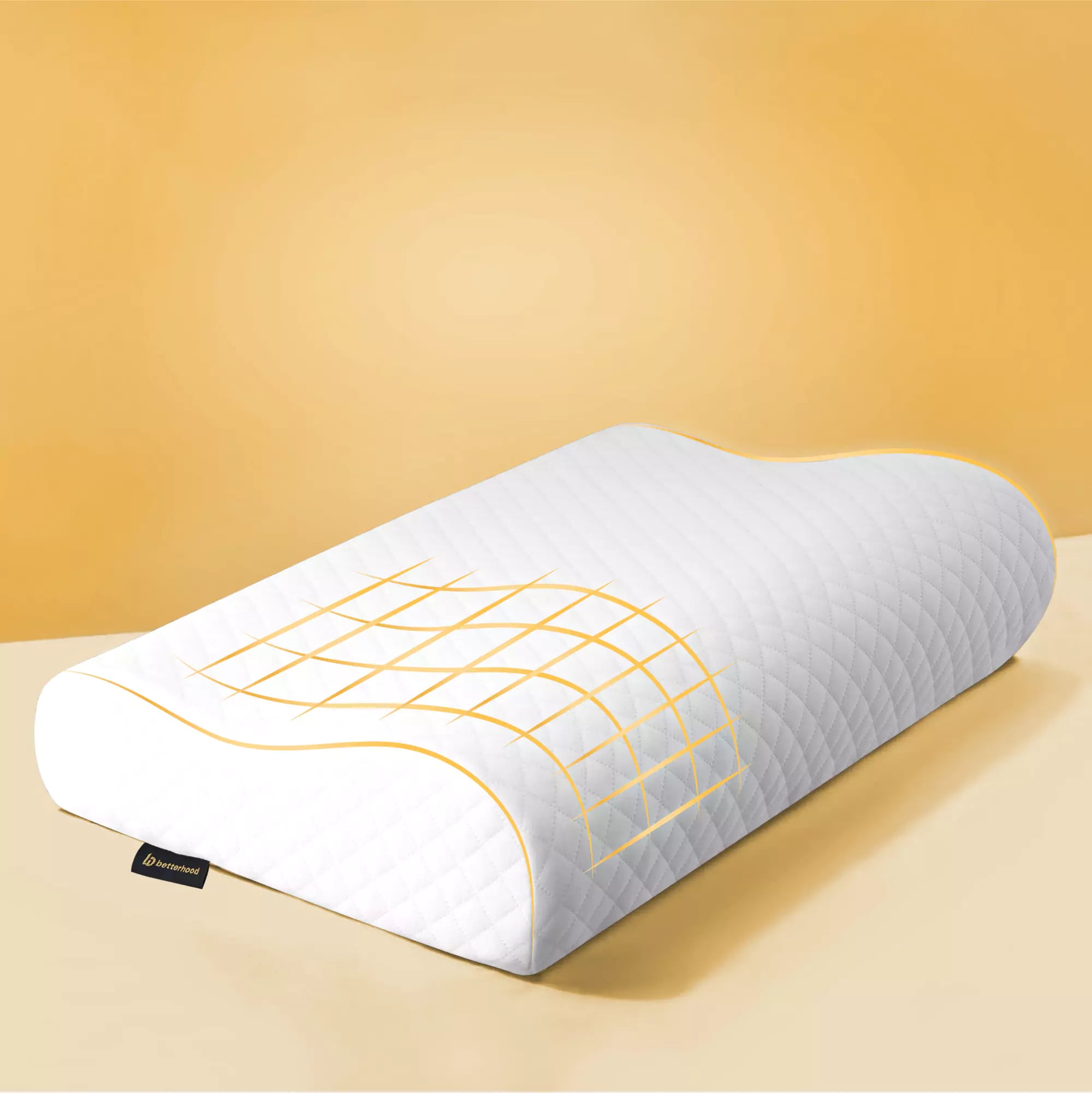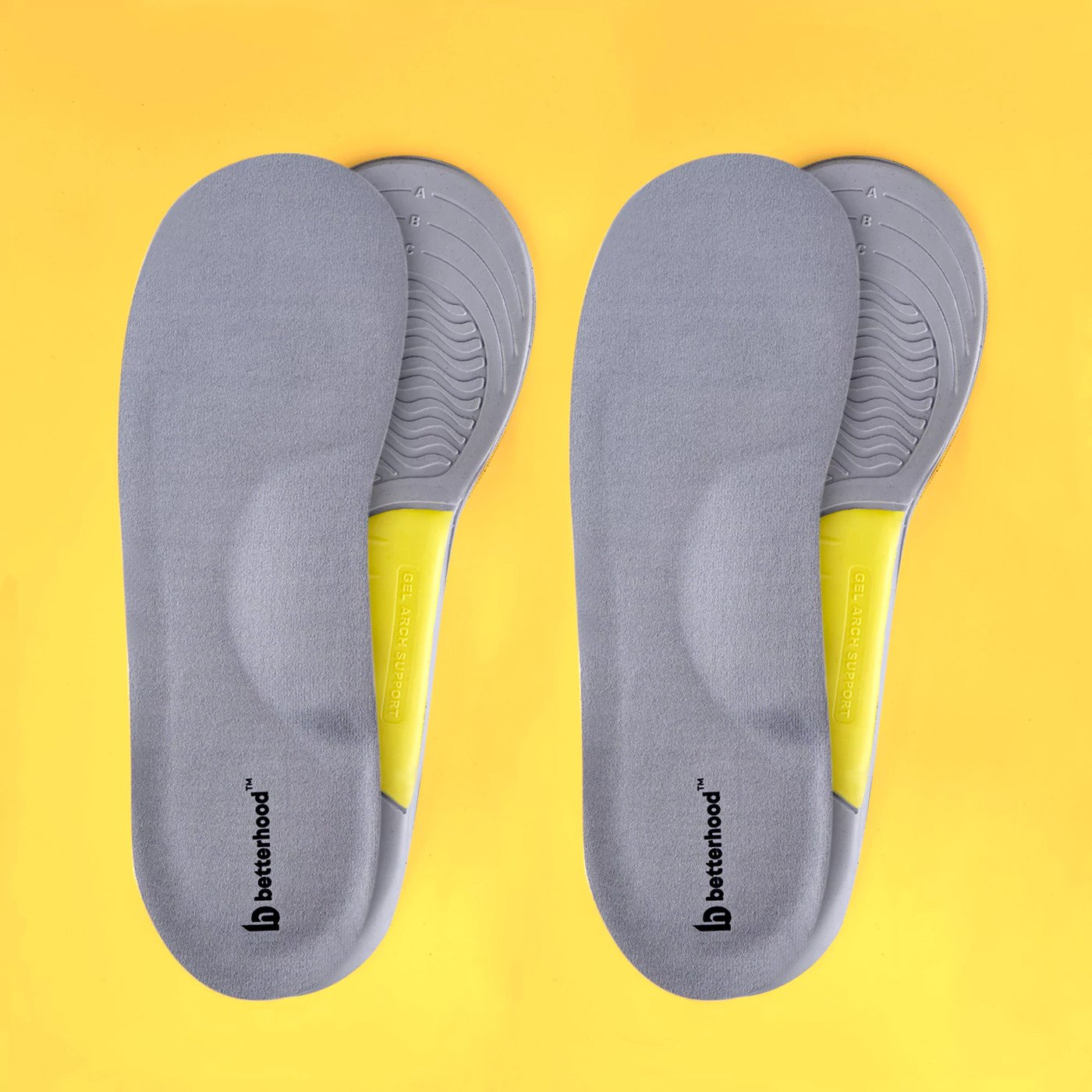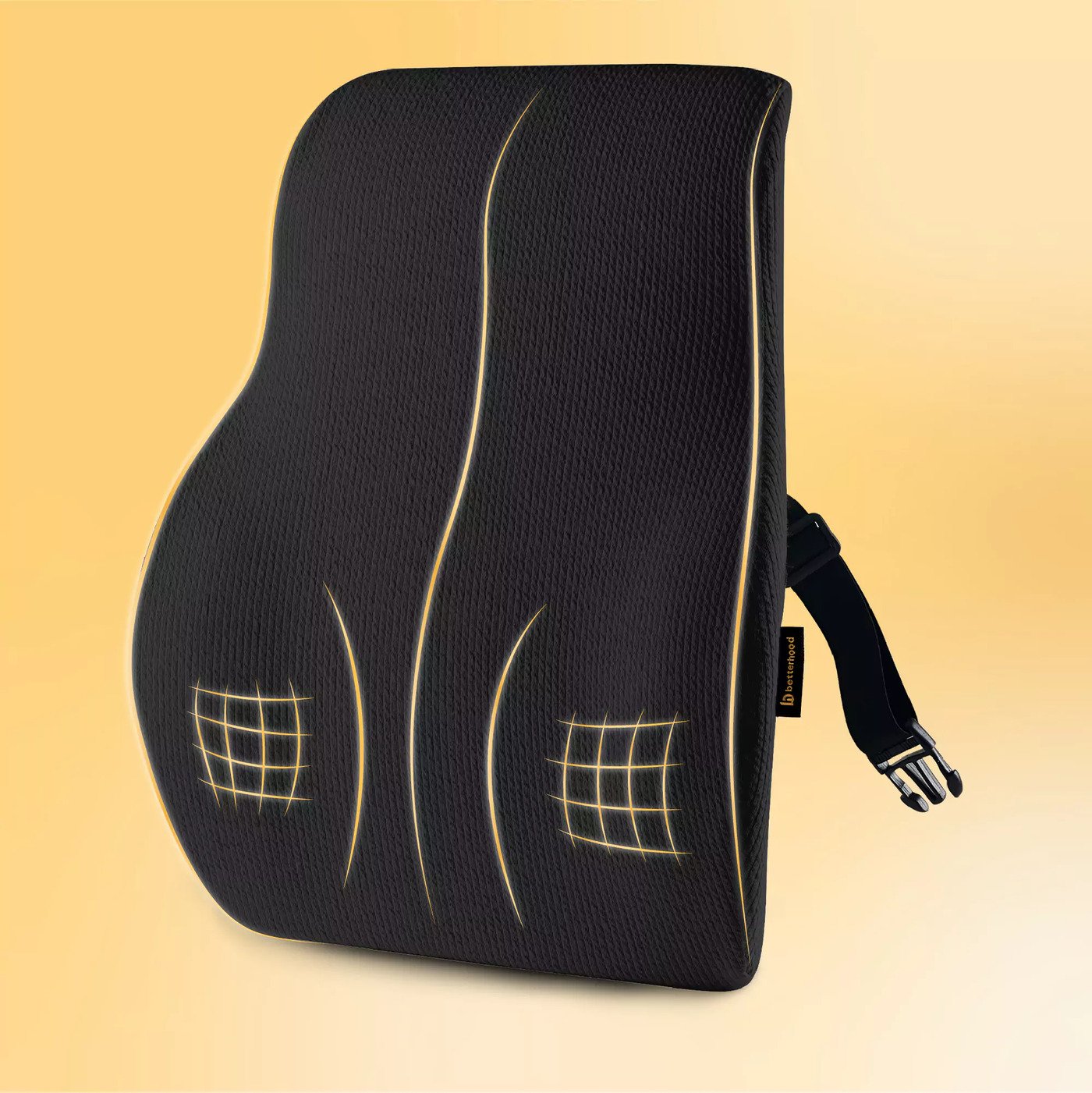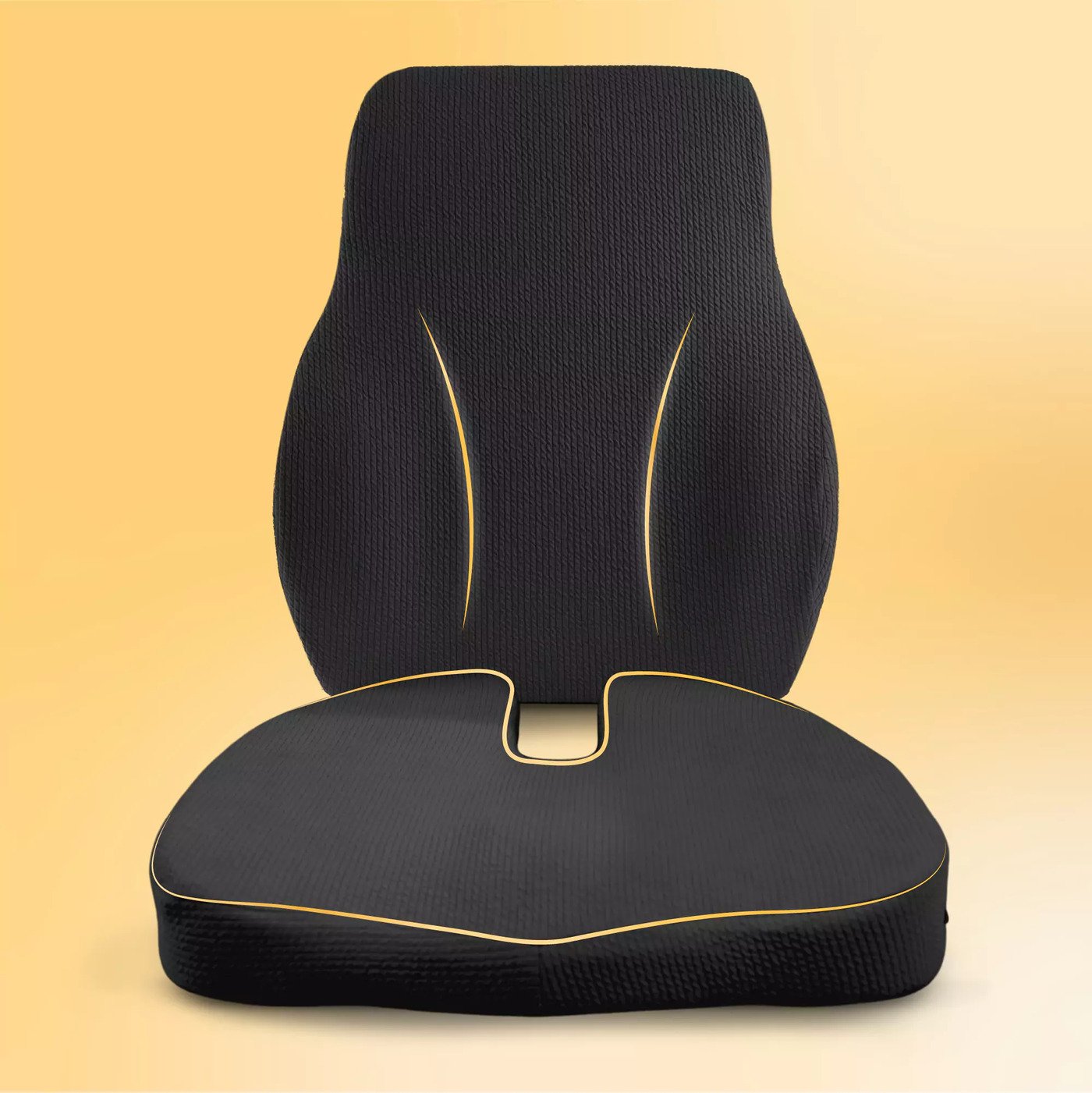Posture is the window to your health.” you might not have heard this statement before, but when you think about your body and its relation to your overall well being, it is one of the most accurate phrases you could use. Think about how you stand, sit or walk throughout the day. Many of these movements and micro-habits, some even performed automatically without any conscious decision, have a huge effect on how your body feels and performs. Whether you are transitioning between meetings and running around at work, picking your kids up from school or comfortably laying on the couch after a workday, the position and hold of your body during these moments determine how much tension your muscles are holding onto, how comfortable your joints are; your energy levels; and even your mood.
Proper posture is erroneously equated with standing up straight or appearing confident when other people are around. Proper posture is much more and much greater than that. Proper posture is the consistent, normal alignment of your musculoskeletal system – your bones, muscles, ligaments, and tendons – so they’re all in line and functioning without restriction, balanced and stable and pain-free. When you maintain good posture, your body can function properly and effectively and with less stress in a manner that will enable you to move and rest on a daily basis.
On the other hand, bad posture causes a variety of physical problems. Bad alignment over time accumulates pains, stiffness, tiredness, and can even prevent essential functions such as breathing and digestion. One of the more infuriating aspects of postural problems is that they accumulate over time and gradually. Many times, it will take persistent pain or annoyance to get someone to notice that the problems were caused by your posture.
In this modern day and age, we’re more posture-disordered than ever. Increasingly, our lives are dependent upon technology these days, and as such, we’re sitting increasingly longer hours each day -often in front of a computer screen, tablet screen or phone screen. This repetitive form of posture only encourages forward head posture, rounded shoulders, and slouched backs; all of which subject our muscles and joints to increasingly more stress. Repetitive movement, static posture, and overall low rates of physical activity are responsible for muscle imbalances and compromised postures.
It is also important to note that posture is unique to each individual. Everyone’s got a different set of bones, muscles, and daily habits. And so there isn’t a single “perfect” posture – good posture is simply learning your own natural stance that will let your body move in the most useful ways possible, without wear and tear.
In this article, we’ll cover the fundamentals of posture: what it is, really, why you’ll want to care, and why it impacts your overall health; most importantly, we’ll cover easy, actionable steps to enhance and enhance your posture, enhance your comfort, and enhance overall mental and physical health. The more you focus and make some sensible changes, you can actually do better and, in the process, create the healthiest, most comfortable, and most confident version of yourself.
What Is the Anatomy Behind Good Posture?
Good posture is not just a description of your sitting and standing, but also of how your spine is constructed and also how your spine adapts and moves along with the rest of your body. The spine itself is a three-dimensional curved framework that functions with three principal functions of support, protection, and movement. Let’s disassemble to see how important good posture is.
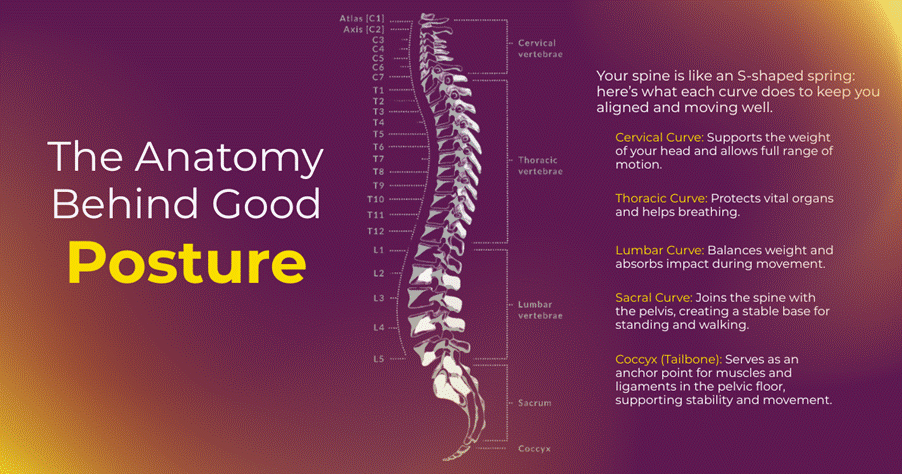
What Are the Natural Curves of the Spine?
The adult human spine is not a straight stiff rod but an enormously flexible and elastic column composed of discrete units named vertebrae stacked upon each other. The stack consists of four distinct natural curves, and these are precisely the secrets of spinal function. These are not arbitrary curves but have evolved to resist body weight, sustain mechanical loads, dissipate shock during movement, and provide for the flexibility to move the body through a large range of motion. Let us discuss each curve in detail and why they are important:
Cervical Curve (Lordosis)
● Location: Neck region, spanning from the first cervical vertebra (C1) to the seventh cervical vertebra (C7).
● Shape: Inward curve (concave when viewed from the side).
● Function: The cervical curve supports the head’s weight, roughly 10 to 12 pounds. It minimizes force needed by muscles to hold the head upright, hence preventing fatigue. It also permits the free swinging of the neck so you can tilt, nod, side to side head movement, and perform other movements required for speech and every day function. Proper curvature in this region is necessary in helping maintain correct posture and prevent neck strain.
Thoracic Curve (Kyphosis)
● Location: Upper and mid-back region, from the first thoracic vertebra (T1) to the twelfth thoracic vertebra (T12).
● Shape: Outward curve (convex).
● Function: The curve provides the normal shape of the upper back and also helps to form a protective thoracic cage that contains vital organs like lungs and heart. It is also the area where muscles of high significance in breathing and movement of the upper segment are attached. The kyphotic curve in this segment allows the rib cage to be capable of expansion and contraction during breathing. Besides that, it braces the upper part of the body that is extremely vital in rotation, stabilization, and lifting.
Lumbar Curve (Lordosis)
● Location: Lower back region, encompassing the first lumbar vertebra (L1) through the fifth lumbar vertebra (L5).
● Shape: Inward curve (concave).
● Function: The lumbar curve sustains much of the body’s weight, particularly in lifting, walking, and standing. It functions as a shock absorber and cushions the spine against forces of everyday life. The curve also maintains the center of body gravity and balance. An ideally shaped lumbar curve enables even distribution of forces and stresses throughout the spine and pelvis, avoiding injury and enabling economical motion.
Sacral Curve (Kyphosis)
- Location: At the base of the spine, formed by the sacrum, which is a set of five fused vertebrae (S1 to S5).
- Shape: Outward curve (convex).
- Function: Sacral curve is the significant transition area between spine and pelvis. It’s a tough, hard foundation that distributes and absorbs body weight of the top downwards to hips and legs. It stabilizes pelvis and spine and enables improved standing, walking, and load carrying. Alignment of sacral curve is critical for complete spine stability and good posture.
Coccyx Curve (Kyphosis)
● Location: The very bottom of the spine, formed by the coccyx or tailbone, which typically consists of 3 to 5 small fused vertebrae.
● Shape: Outward curve (convex).
● Function:Although very little weight is carried by the coccyx in comparison to other regions of the spine, it is a significant place for the attachment of many muscles, tendons, and ligaments. These help in pelvic floor support, specifically bladder and bowel continence and suspension of pelvic organs inside the pelvic cavity. Coccyx also helps with sitting stability and balance as well as with shock absorption during sitting activities such as sitting down or positional change.
Composed together, these natural bends allow the spine to function as an active and dynamic structure. These curves must be maintained in healthy alignment so that a person can have good posture, prevent the possibility of injury, and have fluid, injury-free movement throughout their life.
Why Do These Curves Matter for Posture?
When these curves are aligned and balanced, they form an S-curve profile, and you can stand erect without great muscular force. This equilibrium:
● Reduces muscle strain:When curves are balanced, there is less effort for muscles to maintain you in an erect position.
● Distributes mechanical forces: Balanced curves are shock-absorbing like a spring and shield vertebrae and intervertebral discs from abuse.
● Promotes efficient movement: Good alignment allows pain-free, effective patterns of movement in daily tasks.
But when these curves are distorted or flattened by poor postural habits (e.g., slouching, slumping, or leaning forward), they may:
● Overload specific muscles and ligaments and lead to pain and fatigue.
● Obstruct breathing by limiting rib cage expansion.
● Press against nerves and vessels, producing numbness, tingling, or circulatory problems.
● Cause additional wear-and-tear on joints and discs, setting one up for degenerative changes in the long term.
The Role of Intervertebral Discs
Between a vertebra and the next is a cartilaginous cushiony disc containing a gelatinous nucleus pulposus. Discs serve as shock absorbers, responding to forces that result from daily activities. Spinal alignment forces the forces equally across discs, maintaining their health and the prevention of herniation or degeneration.
Supporting Structures: Muscles and Ligaments
● Muscles:Deep core muscles such as the multifidus and transverse abdominis, and the larger back muscles (such as the erector spinae), are responsible for stabilizing and moving the spine.
● Ligaments: Dense bands of connective tissue (such as the anterior and posterior longitudinal ligaments) can stabilize the vertebrae and restrict excessive movement that may lead to injury.
When these supportive structures are rigid and flexible, they serve to support the usual curvature of the spine and reinforce even better posture.
Posture Is Dynamic
Proper posture does not imply remaining in a fixed position each day. Proper posture implies balanced alignment of natural curves while moving and transitioning from one position or activity to the next throughout your day. Gradual changes, like moving from one sitting position to another or just standing up to stretch, decrease pressure on the spine and give your spine a chance to provide healthy curves.
As soon as you start appreciating the natural shape of your spine, and the design behind that shape, you start owning up to what is probably your most valuable and revered cargo for your entire career or lifetime. The twists of your spine are not cosmetic or accident; they’re an in-built design for good motion, balance, and shock dissipation. By respecting these curves you can do away with or reduce distress, enhance performance, and hopefully be pain-free in your spine for years to come.
How Do Muscles Support Posture?
Posture is not passive bone alignment, it’s an active process relying on muscles acting together in tension. Your active support system are muscles and they never stop adjusting to make you upright, balanced, comfortable, and pain-free sitting, standing, and moving. Let’s go into more detail on the major muscle groups of posture.
Core Muscles: The Body’s Central Support System
● What They Are:The center consists of a shroud of muscles that surrounds and supports the trunk. Not your “six-pack” abs alone. Your transverse abdominis, multifidus, pelvic floor muscles, diaphragm, and your back extensors (erector spinae) are all part of your deep stabilizers.
● What They Do: They create a corset around your spine and pelvis, supporting the spine and restricting motion. The core is a centralized hub when it’s powerful and well-coordinated, preventing excessive lumbar spine motion, distributing forces effectively, and shielding vertebral discs.
● Why It Matters: A poor or dormant core may result in a “swayback” posture, excess lumbar lordosis, or inadequate spinal support for bending, twisting, or lifting motions.
Back Muscles: The Spinal Guardians
● What They Are: The erector spinae (a three-column series of parallel columns of muscles) extend from the lower back to the upper neck vertically along the spine.
● What They Do: These muscles work tirelessly to hold your torso erect against gravity, maintaining the natural spinal curves. They also stabilize the vertebrae during bending, lifting, and twisting movements.
● Why It Matters: When these muscles are weak or fatigued, you’re more likely to slouch or round your shoulders forward, leading to strain in the neck and lower back.
Gluteal Muscles: The Hip Stabilizers
● What They Are: The largest and strongest gluteus maximus, gluteus medius, and gluteus minimus muscles constitute the buttock area.
● What They Do: They are responsible for extension, rotation, and abduction of the hip. They stabilize the pelvis to level and align it, having a direct impact on lumbar spine position.
● Why It Matters:Weak or inactive glutes are a common cause of an anterior pelvic tilt (when the front of the pelvis drops down), resulting in excessive lumbar lordosis (swayback) and low back pain.
Leg Muscles: The Foundation Builders
● What They Are: Quadriceps (front of thigh), hamstrings (back of thigh), calf muscles (gastrocnemius and soleus), and knee wrap-around muscles are the major muscles of the legs.
● What They Do: They form a solid basis of posture by regulating knee and hip alignment. They enable you to stand, walk, and move from point to point without falling into poor posture.
● Why It Matters: For instance, a tight hamstring will cause the pelvis to go into posterior tilt (flatten the lumbar curve), and weak quads will make it more difficult to manage movement such as rising from a chair, potentially resulting in lower back compensation.
The Subtle Dance of Postural Control
● Continuous Micro-adjustments: Although you may think you’re not moving “still,” your muscles are constantly performing small contractions and releases to maintain your body upright. The micro-adjustments work with small variations in your center of gravity such as a small lean forward or sideway move.
● Neuromuscular Coordination: Bad posture is not just about brute force. It is about coordinated muscles firing off one after the other to stack and balance your body. This needs a healthy nervous system, effective proprioception (your sense of where your body parts are) and flexible joints.
The Consequences of Imbalance
When part of this postural system is weak, tight or uncoordinated, the whole system becomes unbalanced. For example:
● Tense chest muscles and weak upper back muscles may result in forward head posture and rounded shoulders.
● Weak core muscles will cause the lumbar spine to overwork and result in low back pain or even disc problems.
● Tight hip flexors (from sitting for long periods) may tilt the pelvis forward, stressing the lower back and hips.
Keeping Your Posture Muscles Healthy
Posture-strengthening muscles are not a one-and-done repair job, but they need regular attention through:
- Strengthening exercises: Planks, bird-dogs, bridges, and deadlifts.
- Stretching: Targeted stretching of knotted areas such as hip flexors, chest, and hamstrings.
- Movement breaks: Changing positions during the day to prevent static muscle fatigue.
- Postural awareness: Awareness of your positioning of your body during the daily tasks, such as sitting at work or standing in queue.
Muscles build the “active scaffolding” that keeps your posture erect. When these muscles are well-coordinated, flexible, and healthy, they perform like a master orchestra, keeping your body in balance and your spine in peak condition. Missing a single one of these muscle groups disrupts the entire system and causes pain and eventual harm. Focusing on muscle health and listening to how your body is feeling will allow you to remain in good posture and avoid future pain.
Why Are Joints and Fascia Important?
Posture is not just a matter of how strong your muscles are, but also a matter of how well your joints can function together and the health of your body’s connective tissue. Let’s look at why joints and fascia are critical to healthy, balanced posture:
Joints: The Body’s Dynamic Hinge Points
- What They Are: Joints are the point at which two bones intersect, functioning as hinges or pivot points to facilitate movement and flexibility.
- Their Role in Posture: Well-aligned joints share your body weight equally so forces are balanced and one spot isn’t weighing more. They give movement its mechanical framework and enable muscles to function properly.
- Common Posture Issues:
- Pelvic tilt: When your pelvis tilts too far back (posterior tilt) or forward (anterior tilt), it alters the position of your spine and legs, straining your lower back or knees.
- Uneven hips or shoulders: Misalignments here can create a chain reaction in the spine and legs, producing compensatory motion and muscle imbalance.
- Knee and ankle positioning: Misligned knees (bow legs or knock knees) or pronated feet can impact the whole-body alignment.
- Why It Matters: Your muscles must strain more to compensate for misaligned joints in order to carry you. This can result in ultimate fatigue, stress, or frequent pain in the lower back, hips, or neck.
Fascia: The Body’s Inner Web of Support
● What It Is: Fascia is a three-dimensional, unbroken web of connective tissue that encases muscles, bones, organs, and nerves.
● Its Role in Posture:
○ Structural Integrity: Fascia acts as the internal support system of the body, keeping everything in place and position.
○ Force Transmission:Fascia carries mechanical forces throughout the body, enabling movement and changes of posture to be smooth and effective.
○ Tension Lines: Properly balanced fascia is a balance of tension on “lines” in the body such as the back line, front line, and spiral lines that support the body to remain in balance and move freely.
● Common Fascia Issues:
○ Tight fascia: May be caused by repetitive motion, poor posture, trauma, or sitting for long periods.
○ Fascial adhesions: When fascia gets “stuck” to itself or to other structures, it can restrict movement and pull muscles and joints out of alignment.
● Real-World Example:
○ Tight fascia in the chest and shoulders can create a rounded shoulder posture, pulling the head forward and causing strain in the neck and upper back.
○ Restricted fascia in the lower back or hips can reduce hip mobility and contribute to low back pain or sciatica-like symptoms.
Maintaining Healthy Joints and Fascia
● Regular Movement: Joints were meant to move! Regular joint mobility through walking, stretching, and movement variety keeps joints well-lubricated and well-aligned.
● Stretching & Flexibility: Dynamic and static stretching may be used to keep joint range of motion up and fascia from getting too contracted.
● Yoga and Mobility Work: Dynamic and static stretching may be used to keep joint range of motion up and fascia from getting too contracted.
● Myofascial Release Techniques:
○ The use of foam rollers, massage balls, or stretching to “release” areas of fascial restriction can decrease tension and realign normal movement patterns.
○ Techniques such as self-myofascial release or visiting a professional (e.g., massage therapist or myofascial therapist) can be helpful too.
● Postural Awareness: Little awareness such as making slight adjustments to keep your weight evenly on both feet, or your pelvis level can also align your joints and ease fascial tension in the long run.
Joints and fascia are the “silent partners” of your musculoskeletal system. Healthy, well-aligned joints enable your muscles to function normally, and flexible, responsive fascia keeps it all together and in balance. Overlooking joint alignment or fascial integrity can create compensations and pain such as a frozen door hinge or a creased bed sheet that distorts everything out of kilter. By prioritizing movement, flexibility, and mindful awareness, you are keeping joints and fascia healthy, allowing for good posture and preventing strain or injury.
What Does Biomechanics Tell Us About Good Posture?
Biomechanics is the study of the way forces behave in the body and affect movement, balance, and posture. Biomechanics explains in good posture how your body distributes weight, absorbs shock, and integrates muscle contraction to allow stability and avoid injury.
- Weight Distribution: The weight of your body in perfect posture is shared equally across your feet when standing. Uniform distribution of body weight reduces pressure on any single joint or muscle group and, therefore, reduces the wearing effect over time. For example, if more weight is placed on one foot or unevenly on both soles, your hips, knees, and spine may become misaligned and lead to pain or injury.
- Ground Reaction Forces: When you walk, stand, or run, forces act through your feet trying to push away from the ground in the opposite direction, referred to as ground reaction forces. Ground reaction forces pass up through the pelvis and legs and influence posture and balance overall. Good posture ensures these forces are efficiently transmitted and absorbed, putting fewer pressures on muscles and joints.
- Kinetic Chains: Your body is an interconnected system called kinetic chains, meaning movement or position in one area will have an influence elsewhere. An example would be a bad posture in your neck or shoulder that causes compensations along the whole spine, hips, or knees. It’s valuable to understand kinetic chains because it demonstrates how an imbalance in a small area can create a ripple effect and become pain or dysfunction somewhere else along the chain.
With these biomechanical principles in mind, professionals can better engineer ergonomic solutions like adjustable office chairs or supportive walking shoes and create specific exercises that foster balanced posture and minimize injury risk. This information is also utilized to inform physical therapy and rehabilitation methods so people can recover proper alignment and functionality [4].
How Does Modern Life Affect Our Posture?
How Does Sitting for Long Hours Change Our Bodies?
In our contemporary lifestyle, our daily activities are predominantly done in a sitting position: typing away on keyboards, driving, texting on smartphones, and watching television. Although these practices don’t appear to be harming us, the long-term effect of prolonged sitting is seriously impacting our posture and overall well-being.
Static Loading: The Hidden Culprit
When we sit for a long period particularly in one position, our muscles and connective tissues experience what is known as static loading. That is, they are subjected to being held in a constant position without movement. Unlike dynamic movements (such as walking or changing position), static loading causes muscle fatigue and circulatory insufficiency in certain places.
Muscle Fatigue and Weakness
- Inactive Core Muscles: Sitting for long periods and getting minimal movement will cause your core muscles such as the abdominals and back extensors to shut down. These are critical muscles that will help support your spine. Without these being used, some other muscles must compensate, usually exerting pressure on the lower back.
- Weak Postural Muscles: Postural muscles like the erector spinae (running along your spine) and the gluteal muscles (buttocks) also become less active when you’re sitting. Over time, this leads to a weakened support system for your spine, making it harder to sit or stand up straight.
- Slouching Spiral: As these muscles weaken, it becomes easier to fall into poor postural habits, creating a cycle where slouching begets more slouching.
Tight Hip Flexors: Locked in a Shortened Position
- Why It Happens: The hip flexors (such as the psoas and iliacus muscles) attach from your pelvis and lower back to your thigh bone. When you sit, these muscles are contracted in a shortened position for hours at a time.
- Consequences: Shortened hip flexors cause the pelvis to be pulled forward, tilting the lower back into its most extreme inward curve (hyperlordosis or swayback). This can invade spinal structures and generate lower back pain.
- Ripple Effects: Shortened hip flexors also limit hip mobility, decrease the efficiency of walking, and generate imbalances extending upward into the spine and downward into the legs.
Rounded Shoulders and Forward Head Posture
● What’s Happening: Slouching forward over your phone or computer has a tendency to form a rounded shoulder position. As your head pokes out in front, or forward head posture, also known as “tech neck.”
● Why It’s a Problem:
○ Neck Strain: Your head is roughly 10-12 pounds heavy and for each inch it sticks out forward, the weight on your neck muscles approximately doubles.
○ Muscle Imbalances: Your neck and upper back muscles have to work harder to hold up your head, resulting in stiffness and fatigue.
○ Nerve and Blood Vessel Compression: When it is out of alignment, nerves and blood vessels at the base of the neck and shoulders get compressed, occasionally resulting in tingling, headaches, or decreased blood flow.
Long-Term Consequences
Poor posture from prolonged sitting isn’t just about temporary aches. Over time, these adaptations can cause:
● Chronic Lower Back Pain: Weakened core and back muscles and an asymmetric pelvis subject the lower back structures to excessive stress.
● Muscle Imbalances: Certain muscles hypertrophy and become overactive (e.g., hip flexors and chest muscles), while others weaken and under fire (e.g., glutes and upper back muscles).
● Joint Degeneration: Misaligned joints degenerate unevenly and risk osteoarthritis or degenerative disc disease.
● Reduced Mobility: Constricted fascia and tight muscles limit your ability to move freely and comfortably.
Taking Action: Movement is Key
To combat these issues, incorporating movement throughout your day is crucial. Here’s how:
● Movement Breaks: Stand up, stretch, or walk for at least 2-3 minutes every 30-60 minutes of sitting.
● Ergonomic Seating: Position your chair and desk so that your feet rest flat on the floor, knees at 90 degrees, and your screen at eye level.
● Stretching and Strengthening: Routine stretching of hip flexors, chest, and shoulders, in conjunction with core-strengthening exercise, can rebalance and relieve strain.
● Postural Awareness: Even just checking in with your body throughout the day rolling your shoulders back, lengthening your spine can make a difference in your posture.
Sedentary habits of modern life change us slowly but irresistibly. Knowledge of how to change in such a way as tight hip flexors, weak core muscles, and slumped shoulders has the power to encourage us to transcend the habits of sitting for hours and regain a healthier, more aligned posture. Simple little adjustments, such as standing more frequently or stretching at regular intervals, can undo the tendencies and make your body feel strong, comfortable, and pain-free.
What Role Does Technology Play in Postural Issues?
The Impact of Screens on Our Bodies
Technology has become an integral part of life. From phones to computers, tablets to gaming systems, the screen surrounds us. These technologies have made life easier, but they also bring with them a new problem for posture and the musculoskeletal system.
The Weight of Tech Neck
● What is Tech Neck?
“Tech neck” is a condition that refers to the repeated strain and pain that comes from hunching over to view screens for hours on end.
● The Mechanics:
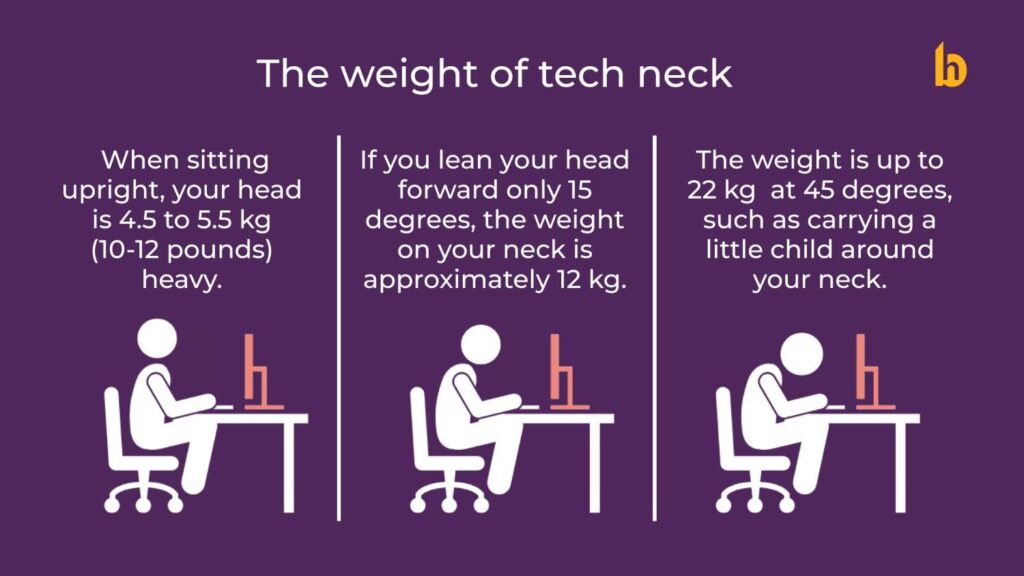
This added weight causes tension to the cervical spine (neck vertebrae), and bearing muscles and ligaments. With time, it leads to muscle strain, tension headache, compression of the disc, and gradual joint wear.
Screen Time and Spinal Alignment
- Visual Strain:
Screengazing causes eye fatigue and strain, computer vision syndrome. This will cause leaning forward towards the screen, head jutting out and shoulders rounding. - Rounded Shoulders:
The forward head posture (tech neck) is typically found with rounded shoulders. This also disrupts the natural curvature of the upper back (thoracic spine) and can also weaken the shoulders muscles (such as the rhomboids and lower trapezius). - Muscle Imbalances:
Tense pectoral muscles and stretched upper back muscles reinforce a cycle of bad posture, and the posture reinforces the tension. - Poor Wrist and Hand Posture:
Even regular phone and keyboard use puts stress on wrist and forearm muscles, leading to tension and pain in the upper body.
Long-Term Risks
The posture habits we develop while using technology can lead to:
- Chronic neck pain and headaches
- Constrained movement in the shoulders and neck
- Knots and tension in the upper back
- Degenerative spinal changes in the cervical spine with age
Breaking the Tech-Posture Cycle
Technology is here to stay, but small changes can shatter the tech-posture cycle:
- Raise Screens: Position screens at eye level to minimize the need to lower your head. Simple as this action is, it can cut back significantly on neck tension.
- Take Movement Breaks: Stand, stretch, or roll shoulders every 30-60 minutes.
- Do Neck and Shoulder Stretches: Gentle stretches can reduce tension and improve posture. Examples include:
- Chin tucks: slowly tuck your chin back to move your head onto shoulders.
- Upper trapezius stretch: tilt your head to the side to stretch the other side of your neck.
● Use Ergonomic Setups:
- Adjust chair height so feet are flat on floor.
- Keep elbows at 90 degrees when typing.
- Use supportive chairs that promote an upright sitting position.
● Mindful Screen Use: Check your posture every now and then. Slouching? Creeping shoulders? Small changes during the day count.
Technology is here to stay, but tech-posture issues don’t have to be. Awareness of the situation, frequent changing of positions, and ergonomic modifications can save your neck, spine, and shoulders from unwarranted strain. These simple habits can make a big difference in good posture and avoidance of long-term pain that always accompanies “tech neck.”
How Do Cultural and Societal Factors Influence Posture?
Posture habits are not formed in isolation, they are strongly influenced by the societal and cultural forces that allow us to be able to move, sit, and function in our daily lives.
Work Culture and Posture
In most cultures, today’s workplaces demand hours of sitting in front of desks or screens. These settings have no proper ergonomic support, and individuals end up sitting in inappropriate postures and spending extensive periods of time being sedentary. Without appropriate concern for posture, adjustable chairs, and proper desk levels, workers develop habits of slouching, forward head posture, or rounded shoulders, which result in discomfort and musculoskeletal disorders in the long run.
Education Settings and Early Habits
Schools have a major influence on the formation of posture habits early in life. Yet, most desks and chairs are not designed to fit the entire continuum of child size and developmental stages. All too often, the student is then coerced into unhealthy posture habits, such as slouching or leaning to one side, that become established patterns carried over through adult life.
Social Norms Around Appearance and Body Language
Social conventions regarding how to “should” stand, sit, or posture can be a double-edged sword. On the one hand, to be reminded to “stand up straight” is generally equivalent to concepts of professionalism, confidence, and sex appeal. On the other hand, social conventions have a tendency to enforce people into overly rigid and unnatural postures that are self-conscious or even harmful if maintained for extended periods of time. The need to look poised or in charge sometimes generates tension instead of relaxation.
Fashion’s Influence on Posture
Fashion trends also affect how we hold our bodies. For example:
● High Heels: Habitual wear of high heels tilts the body forward, resulting in increased lordosis of the lower back and alteration of spinal alignment. In the long run, it results in backache and muscle imbalance.
● Tight Clothing: Constrictive clothing may restrict movement and change normal muscle function, thus individuals shift posture to suit restriction or discomfort.
Digital Culture and Body Awareness
Social media puts a new twist on posture’s influence. The ubiquity of filters, computer-moded images, and idealized postures can create unattainable ideals of how one’s body “should” appear. It can increase body dissatisfaction and promote defensive or manufactured postural responses, as individuals try to attain idealized postures instead of embracing their own natural posture.
Societal and cultural forces are blended into difficult pressures that impact our day-to-day posture habits. From the position of our workspace to social decorum and style, the pressures may reinforce good posture or add to poor habits. Familiarity with these pressures is a key first step in building posture that is not only socially self-assured but also comfortable and supportive of long-term health.
What Are the Science-Backed Benefits of Maintaining Good Posture?
How Does Good Posture Improve Physical Health?
Using proper posture is so much more than standing up straight, it has a deeply impactful effect on your overall physical health. Scientific studies highlight a number of key advantages that illustrate how posture influences your body function and overall long-term health:
1. Stability and Balance
Proper posture keeps your spine erect, and your body weight evenly distributed over your bones, joints, and muscles. This even load is important because it avoids putting extra weight on any particular joint or region. If your posture is not correct, then some joints or some muscles will have to carry more weight than they can support, and this can cause pain, inflammation, and damage.
● Reduced Risk of Falls: Of course, with age, the strength of your muscles and balance will weaken. Posture assists with balance in that it keeps your center of gravity over your base of support (your feet). This reduces the likelihood that you might fall or lose balance, and this is one of the primary reasons for injury in older adults [7].
● Joint Protection: Correct posture reduces abnormal stress on joints such as knees, hips, and ankles. This prevents wear and tear and prevents degenerative diseases like osteoarthritis.
2. Mobility and Movement Efficiency
When your posture is correct, your joints and muscles perform well in an attempt to generate smooth and synchronized movement. It has several significant implications:
● Improved Joint Health: Posture allows cartilage of joints to be loaded equally. This avoids unequal wear that results in joint stiffness and pain.
● Optimal Muscle Function: Activating muscles of importance in posture, like core muscles, back extensors, and gluteals, activates them and normalizes their strength. This avoids overuse or underuse of individual muscles, decreasing muscle imbalances that lead to joint damage.
● Easier Daily Activities:From bending and walking to standing and lifting, good posture makes movements easier to do. It enhances your functional capacity, which makes it easier to accomplish daily activities with fewer aches and pains.
● Lower Risk of Chronic Pain: Faulty posture has the potential to cause frequent strain on muscles, ligaments, and discs, leading to chronic back, neck, or joint pain. Proper posture prevents such situations by maintaining natural curves and alignment of the spine [7].
3. Energy Conservation and Reduced Fatigue
Proper posture is also related to muscle efficiency. When your posture is poor, certain muscles must work overtime to compensate for distortions, expending energy.
● Reduced Muscle Tension: Proper posture keeps muscles at an optimal length-tension relationship, so they do not have to contract quite as hard to stabilize your body.
● Delayed Onset of Fatigue: By reducing unnecessary muscle work, proper posture delays the onset of muscle fatigue. This allows you to remain active, alert, and focused for extended durations without tiring.
● Better Endurance: Standing work, walking, or exercising, proper posture saves your energy reserves, thus more endurance throughout the day.
Additional Physical Benefits of Good Posture
● Enhanced Circulation and Nerve Function: Proper posture minimizes pressure on the nerves and the blood vessels. This enhances healthy circulation and nerve transmission, sustaining body-wide function and eliminating numbness or tingling.
● Improved Digestion: Proper posture avoids excessive compression of abdominal organs, enabling healthy digestion and eliminating pains like acid reflux.
● Breathing Efficiency: Proper posture maintains chest wide open and diaphragm free to move, allowing one to breathe more deeply and completely (discussed more in the section on breathing). This optimizes delivery of oxygen to tissues and is a component of overall energy.
Good posture is foundational for physical health because it promotes:
● Evenly distributed weight support and shielding of joints
● Effortless, coordinated, efficient movement
● Lessened muscle tension and delayed fatigue
● Improved circulation, digestion, and breathing
All of these benefits provide you with the liberty to pursue an active, pain-free existence with improved physical function and improved resistance to injury and age. Practicing and maintaining proper posture is all about it not just looking confident, it’s an intelligent investment in your future health and welfare [7].
How Does Posture Affect Psychological Well-Being?
Not only does posture maintain the body upright physically, it deeply influences our emotional and mental well-being as well. More and more research is demonstrating that how we carry ourselves impacts how we feel, think, and experience the world.
1. Boosting Confidence and Self-Esteem
Standing with shoulders back and head held high, or sitting with shoulders back and spine straight, can be an incredibly confidence-granting position. Your body will send the message to those around you of being strong and confident, but also to yourself.
● Body-Mind Feedback: Research has demonstrated that the physical process of taking a confident posture actually feeds back into your brain, reinforcing positive self-concepts and assertiveness. This is to say that your posture can generate an internal sense of power and control that then directs your social and work behavior.
● Improved Social Presence: People who stand upright are typically perceived to be stronger, trustworthy, and charismatic. This is likely to improve how others respond to you, making your social relationships better and opening doors of opportunities.
2. Lowering Stress and Anxiety
The posture you have in your body influences your physiological responses to stress. Slouching or slumping postures tend to accompany defeat, sadness, or withdrawal feelings, cautioning yourself and others of a depressed mood or low energy state.
● Stress Hormone Reduction: Sitting up straight was discovered to reduce the body’s main stress hormone, cortisol. What this actually means is that you can exert stress biologically influence effectively by just altering your posture.
● Resilience and Emotional Stability: Proper posture promotes a resilient stance of readiness and calmness. Bad posture, on the other hand, will support a cycle of negative feelings and tension, helping to create helplessness or fatigue [8].
3. Improving Mood and Mental Outlook
Posture also influences how well you breathe, which directly impacts brain function and emotional health.
● Enhanced Oxygen Flow: Maintaining an open, upright posture provides full, diaphragmatic breathing. This enhances oxygenation to the brain, which enhances mental operation, focus, and mood management.
● Positive Feedback Loop: When your body is “open” and not tense, you are likely to feel good, energized, and motivated. This openness of the body sends a message to your brain that you are safe and competent, and this enhances mood and mental attitude.
● Body Language and Emotional Experience:Since body language affects not only how others perceive us but also how we feel about ourselves, the development of mindful posture practice can be an easy but very powerful intervention for enhancing emotional well-being and social self-confidence.
Why Posture Matters Beyond the Physical
Your stance is a constant quiet conversation between yourself and the environment. It is by defining how you move that you can enhance not only your physical well-being but also the strength of your mind and tranquility of mind.
Posture consciousness has an inexpensive, conscious, easily available antidote to reduce tension, enhance self-confidence, and create a positive outlook, healthy benefits that go across all stages of life.
What Is the Relationship Between Posture and Breathing?
Posture and breathing are closely intertwined, with posture playing a crucial role in determining how effectively we breathe. The way we hold our bodies can either facilitate deep, efficient breathing or restrict it, impacting our overall health and well-being.
How Poor Posture Impacts Breathing
When we slouch, hunch forward, or collapse our chest, the space inside the chest cavity and abdomen becomes compressed. This compression has several negative effects:
● Diaphragm Restriction: The diaphragm is the primary muscle responsible for deep, efficient breathing. It contracts downward during inhalation to allow the lungs to expand. However, when you slouch, the diaphragm’s ability to move freely is limited because the ribs and abdominal organs are pushed inward, reducing its range of motion.
● Reduced Lung Capacity: Compression of the chest cavity physically limits how much the lungs can expand during each breath. This leads to shallow, rapid breathing, often called “chest breathing,” which is less efficient for oxygen exchange.
● Lower Oxygen Intake: Shallow breathing reduces the amount of oxygen reaching the bloodstream and, consequently, the brain and muscles. This can cause feelings of fatigue, lightheadedness, and decreased concentration.
● Increased Tension and Stress: Shallow breathing can activate the body’s stress response by increasing sympathetic nervous system activity (the “fight or flight” system). This heightens feelings of tension and anxiety and may contribute to muscle tightness, especially in the neck and shoulders.
How Good Posture Supports Optimal Breathing
On the other hand, standing or sitting up with shoulders rolled back and spine straight provides the best setup for healthy, effective breathing:
● Open Chest and Rib Cage: Standing or sitting up straight and rolling shoulders back and keeping spine aligned, your rib cage opens enough naturally so the lungs fill to capacity.
● Diaphragmatic Movement: Space in an open position allows the diaphragm to drop all the way down with each breath, welcoming deep diaphragmatic or “belly” breathing. Deep breathing employs the lower lungs, where blood vessels are more numerous, in an attempt to provide maximum oxygen exchange.
● Improved Oxygen Delivery: Increased oxygen use equals improved delivery to all tissues of the body, including the brain. This yields increased mental acuity, alertness, and physical energy.
● Improved Circulation and Relaxation: Good breathing enhances circulation and tends to activate the parasympathetic nervous system that promotes relaxation and recovery. It can lower heart rate and blood pressure, relax muscles, and induce relaxation.
The Feedback Loop Between Posture and Breathing
Breathing and posture are two sides of the same coin in an ongoing feedback loop:
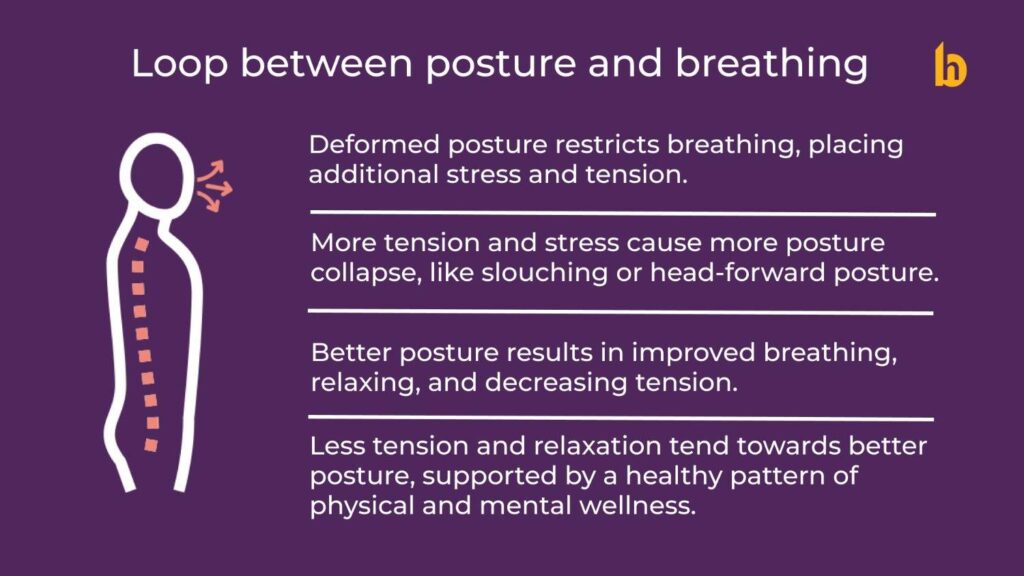
Your posture has a direct impact on your breathing mechanics, and breathing quality greatly determines how well you feel and function. Keeping the posture upright gives you fuller, more efficient breaths that richly condition body and mind and contribute to better overall health, energy, and calmness of mind.
What Are Common Myths About Posture?
Posture is a hot topic with a great deal of traditional thinking, some correct and others incorrect. Knowing the facts behind myths will assist you in creating better, more effective posture habits that function beneficially for your body.
Why Is “Sit Up Straight” Sometimes Bad Advice?
The “sit up straight” directive is probably the most ubiquitous posture recommendation passed on by parents, teachers, and health professionals. Although intended to promote upright posture and discourage slouching, overly rigid adoption can have the reverse effect.
Stiffness and Muscle Fatigue:
Forcing yourself into an unnatural, rigid, perfectly straight position puts unnecessary tension on your neck, shoulder, and back muscles. Your body is going to require continuous effort to stay in this position, which eventually leads to muscle fatigue, pain, and discomfort.
Ignoring Natural Movement:
Good posture does not involve stiffly stiffening up your body into one “perfect” position. Scientific studies tell us that bodies are made to be in motion, with little shifts and adjustments all day long [10]. Micro-movements distribute the mechanical load on muscles and joints evenly, so no single area gets overworked.
Better Advice:
Instead of committing yourself to one fixed posture, try remaining relaxed but vigilant with an alternating stance or sitting position. Constantly change your posture, add frequent micro-movements, take stretch breaks, and stay aware of your body’s sensations. Dynamic posture keeps your muscles working and reduces strain.
Is “Good Posture” the Same for Everyone?
A common misconception is that there is one “correct” posture that applies universally to everyone.
- Individual Differences: Each body is unique. Differences in bone structure, muscular strength, flexibility and daily routine make what is comfortable and healthy for one awkward or even harmful for another.
- Neutral Alignment Over Rigid Ideals: More than attempting to be in a textbook, perfect position, the aim would be to achieve a neutral positioning that honors your body’s natural spinal curvatures, cervical, thoracic, and lumbar. This position protects your joints, minimizes fatigue, and discourages pain.
- Personalized Awareness: The trick to good posture is to pay attention to your body. Pay attention to your tendencies, listen for the whispers that your body offers you, and make changes that are specific to your own needs. This individualized attention is far more powerful than attempting to emulate a generic ideal.
Does Back Pain Always Mean You Have Poor Posture?
- Reality: Poor posture is often one of many possible causes of back pain, but not always the sole reason. Not everyone with back pain has poor posture, and not every person with poor posture has pain.
- Why It’s a Myth: Back pain is a multifaceted disorder with numerous potential causes. It may result from injuries, muscle imbalances, inflammation, disc, or psychological issues like depression, anxiety, and stress. Posture is only one of many.
- Evidence: Research that has tested the association between posture and back pain gives contradictory results. Some people with “poor” posture are pain-free, while others with “good” posture experience chronic back pain [13]. This means that posture cannot be relied on to account for all back pain.
- Practical Implications: If you experience back pain, do not blame posture alone. All the contributing factors may be identified through a comprehensive assessment from a medical professional. The treatment may be physical therapy, corrective exercises to address muscle imbalances, ergonomic realignment, stress reduction, or other medical treatments.
Can Posture Be Corrected Quickly With a Simple Fix?
- Reality: Improving your posture is not a quick fix,it’s a gradual, ongoing process that requires consistent effort, increased body awareness, and sometimes lifestyle adjustments.
- Why It’s a Myth: Many products, such as posture braces, special chairs, or smartphone apps, claim to instantly correct posture. While these tools may offer temporary support, they do not teach your body how to maintain proper posture independently. Relying solely on quick fixes won’t result in lasting improvements.
- Scientific Insight: Long-term posture correction entails developing muscles that are worth it for posture, such as those around your core and upper back, enhancing flexibility, reeducating neuromuscular control, and in some cases, reforming habits such as sitting, standing, or the use of electronic devices [14]. It’s a matter of time and patience.
- Effective Strategies: The best method is through daily posture exercises, body awareness, an ergonomic workplace, and movement breaks. Aids or braces are useful as a short-term adjustment but never substitute active muscle strengthening and habit change for optimal long-term benefits.
Conclusion: How Can You Start Improving Your Posture Today?
After you begin to realize the anatomy and science behind posture, you find yourself becoming aware of posture and how your posture affects your health and well-being. Posture makes you appear more confident, lessens some of the wear and tear on joints and muscles, enables you to breathe more easily, enhances circulation, prevents injury and pain, and leaves you feeling more energized when you’ve accomplished things. With all the amount of stuff we do in our modern life with lots of sitting for extended periods and screen time and other activities of similarly sedentary life, we can then value some real challenges to good posture that may not be so simply overcome and lead to imperfections and bad habits, posturally.
The good news is that you don’t need to overhaul your life in order to improve. Small steps here and there, one at a time, can all cumulatively help you feel and function better if you’re determined to implement them on a regular basis!
- Start with Movement: The best and most practical approach to minimizing postural issues is to simply split prolonged standing or sitting with regular movement breaks. Stand up, stretch, walk around, or perform a series of light exercises every 30-60 minutes. Micro-movements decrease muscle tension, promote circulation, and bring in fresh position or posture.
- Optimize Your Workspace: An ergonomically arranged workspace will guide you into good alignment so you can work without getting tired. Position your chair so your feet are flat on the floor, position your computer monitor directly in front of you at eye level, then position your keyboard and mouse so your wrist is not bending into a poor position. Making small changes many times will provide you with a good foundation for continuing to have good posture for the remainder of the workday.
- Engage Your Core with Mindful Breathing: In addition to promoting relaxation, breathing exercises will also allow you to activate your core muscles, the secret to a healthy, stable spine. Regular practice of deep, diaphragmatic breathing will reduce tension-based pain at the shoulders and neck and make adopting a good posture habit easier.
- Cultivate Awareness and Personalization: One of the best interventions of posture is to simply be more aware of your postural habits throughout the day. You are going to notice periods of time when you have slouched or tensed up. As you begin to become aware of it, you can remind yourself to adjust your position. You also need to remember that not everyone is going to find the same “perfect” posture. Remember, a part of figuring out your own ideal postural alignment is working out what feels normal and comfortable for your body, if you can personalize your postural approach, you will be able to live it more sustainably.
- Commit to Ongoing Care: Remember that posture improvement is not a single finish line – it is a journey. When you perform posture-friendly habits, exercises, and ergonomic changes often, you build resilience against pain and fatigue. If you do them often enough, they no longer require proactivity – they will become a part of your daily habit and lead to a healthier, more comfortable, and more confident you over time!
Your time and attention on fostering your posture are really just an investment in your health and wellbeing. Creating habits that you can adopt today and incorporate in small, mindful steps will help prevent injury and strain while enhancing your level of wellbeing, comfort, and vitality each day!
References:
- Panjabi, M.M. (1992). The Stabilizing System of the Spine. Part I. Function, Dysfunction, Adaptation, and Enhancement. Journal of Spinal Disorders, 5(4), 383-389. https://pubmed.ncbi.nlm.nih.gov/1459347/
- Neumann, D.A. (2017). Kinesiology of the Musculoskeletal System. Elsevier Health Sciences.
- Schleip, R., Findley, T.W., Chaitow, L., & Huijing, P.A. (2012). Fascia: The Tensional Network of the Human Body. Elsevier.
- McGill, S. (2007). Low Back Disorders: Evidence-Based Prevention and Rehabilitation. Human Kinetics.
- Szeto, G.P.Y., Straker, L., & O’Sullivan, P.B. (2002). A Comparison of Symptomatic and Asymptomatic Office Workers Performing VDT Work. Applied Ergonomics, 33(1), 75-84. https://pubmed.ncbi.nlm.nih.gov/11821929/
- Hansraj, K.K. (2014). Assessment of Stresses in the Cervical Spine Caused by Posture and Position of the Head. Surgical Technology International, 25, 277-279. https://pubmed.ncbi.nlm.nih.gov/25225078/
- Grimmer, K., Williams, M., & Gill, T. (1999). The Association Between Musculoskeletal Pain, Function and Posture. Spine, 24(3), 257-262. https://pubmed.ncbi.nlm.nih.gov/10073672/
- Peper, E., Harvey, R., & Lin, I.-M. (2017). How Posture Affects Mood and Stress. Biofeedback. https://pubmed.ncbi.nlm.nih.gov/29267193/
- Kolar, P., Sulc, J., Kyncl, M., et al. (2012). Stabilizing Function of the Diaphragm: Dynamic MRI and Respiratory Muscle Electromyography Study. Journal of Applied Physiology, 112(2), 1796-1805. https://pubmed.ncbi.nlm.nih.gov/22100523/
- O’Sullivan, P.B. (2000). Diagnosis and Classification of Chronic Low Back Pain Disorders: Maladaptive Movement and Motor Control Impairments. Manual Therapy, 5(3), 139-146. https://pubmed.ncbi.nlm.nih.gov/10978961/

